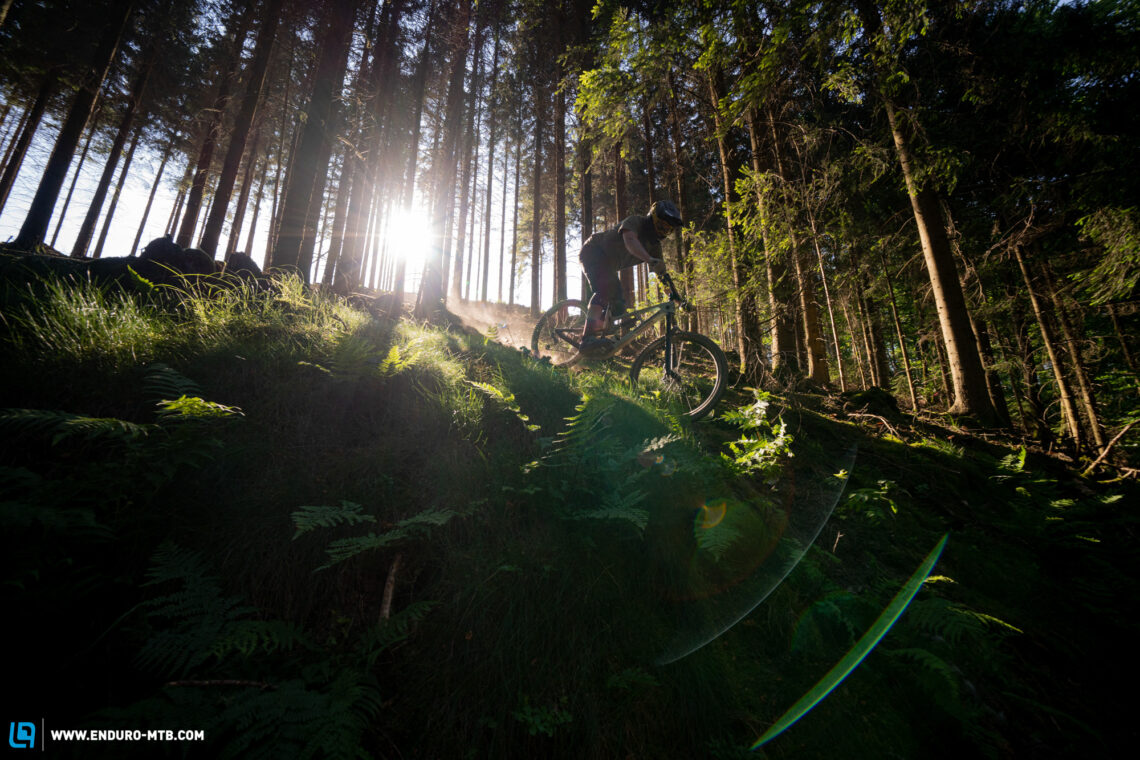New 2023 Rocky Mountain Slayer Carbon 50 first ride review – 🤘🤘🤘
After three years on their previous frame platform, Rocky Mountain have redeveloped their freeride bruiser from the ground up for 2023. The latest iteration of the Slayer rolls into the new season with a new frame, a new wheel-size configuration and maximum suspension travel, which should bring it up to date with the latest mountain bike trends. Did the Canadian manufacturer deliver? We tested the new Slayer to find out!

16.8 kg in size L | € 6,900 | Manufacturer’s website
Rocky Mountain is a household name in mountain biking. The Canadian brand is based in North Vancouver and has actively helped shape our sport, designing and building mountain bikes since 1981. The bikes.com URL alone gives away Rocky Mountain’s venerable age, which the Canadian brand managed to secure in the early days of the net. The Slayer has been an integral part of RM’s portfolio since 2001, making it one of the very few bikes out there that would be legally allowed to down a pint in all 10 Canadian provinces. As the long-travel flagship in Rocky Mountain’s portfolio, the Slayer is the Canadian brand’s undisputed big-mountain rig and freeride bruiser. The latest descendant of the Slayer dynasty looks to be even more potent than its predecessor, generating an intimidating 180 mm of travel front and rear, regardless of the wheel size configuration. Moreover, Rocky Mountain will also release a special park edition, which comes equipped with a 200 mm dual-crown fork. Speaking of wheel sizes, the 2023 Slayer can be configured both as a full 29er, and a mullet bike with a 29″ front wheel and smaller 27.5″ wheel at the rear – regardless of the frame size. This is possible thanks to the new full carbon frame, which relies on a well-thought-out geometry concept and countless new detail solutions. For the sake of clarity: Rocky Mountain’s design team is still fond of metal, which is why the new Slayer will also be available as an alloy version. For this first ride review, we tested the new Rocky Mountain Slayer Carbon 50, which retails at € 6,900, tipping the scales at 16.8 kg. read the full review to find out what the Canadian freeride monster is capable of.

The new 2023 Rocky Mountain Slayer Carbon 50 in detail
For MY 2023, Rocky Mountain waved goodbye to the old alloy swingarm and developed a brand-new full carbon frame from scratch. Like its predecessor, the new Slayer relies on Rocky Mountain’s proprietary “Smoothlink” four-bar suspension design, whereby the bearing layout has been revised over last year’s model to improve the rear triangle’s stiffness. All new Slayer models rely on a horizontally mounted coil shock, which is supported by an additional vertical brace between the top and downtube. The new Slayer also inherits the Ride-4 flip chip from its predecessor, which is positioned in the shock mount and allows you to adjust the geometry and the rear suspension’s final progression. Moreover, there’s an additional flip chip in the dropout, which Rocky Mountain borrowed from their trail and enduro bikes, the Instinct and Altitude. The frame is a harmonious ensemble of straight lines, which makes for a proportionate and – except for the additional vertical brace – simple look.
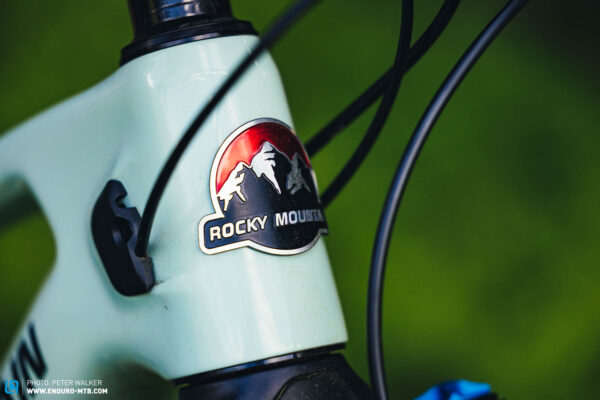
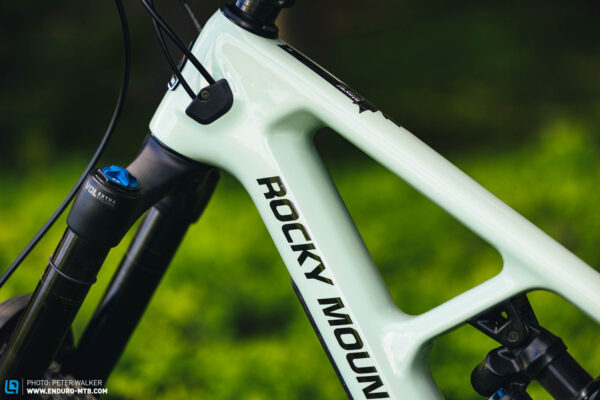
With its unmistakable silhouette, the new Slayer is distinctly recognisable as a Rocky Mountain, with small yet catchy details reinforcing its strong identity. Amongst them are the beautiful Rocky Mountain head badge, the small Slayer mask at the back of the seat tube and the maple leaf on the top tube. In our opinion, Rocky Mountain shouldn’t have covered the maple leaf with the rectangular model sticker, but this can be easily removed with a bit of patience. All Slayer models are available in two paint finishes: you can choose between the colour scheme of our test bike or a dark grey-black finish, both of which are, in typical Rocky Mountain fashion, named after famous songs. Colour scheme 1 is called “Another brick in the wall-red, wind of change-turquoise, black dog-black” while colour scheme n. 2 is called “Smoke on the water-grey, black dog-black and one bourbon, one scotch, one beer-gold”. Unfortunately, Rocky Mountain are not (yet) planning to release a “let-the-sunshine-in-yellow” or “Dirt-repellent Taylor Swift-shake-it-off-pink” version – and neither a “The World Painted Blood-Slayer-red” finish.

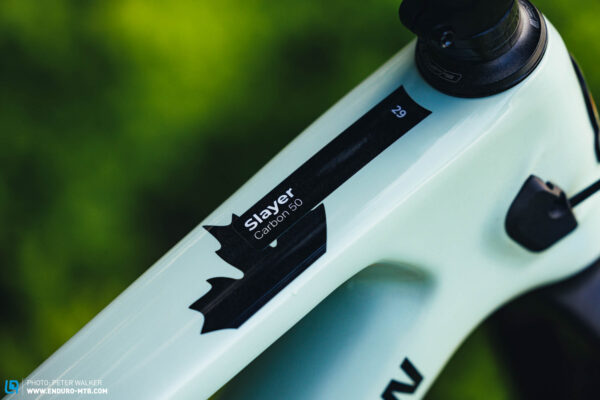
Into the penalty box! – The new penalty box storage compartment of the Rocky Mountain Slayer Carbon 50 in detail
With the Slayer’s new carbon frame also comes a brand-new storage compartment. However, this is exclusive to the carbon bikes, while the alloy model relies on a conventional, closed downtube. The new proprietary storage compartment, which is aptly named “Penalty Box”, is covered with a plastic lid, which interlocks with the frame at the bottom of the opening and is secured by a magnetic strip at the top, with a small lip to help you open it. Since the cover doesn’t double as a bottle cage holder and only has to support its own weight, this should be enough to lock it securely in place and prevent it from rattling on the trail – at least in theory! However, with our test bike, we lost the plastic lid for good after just a few laps, which is presumably not what the Penalty Box’s development team had in mind… The storage compartment comes standard with two pouches, one of which was designed for multitools and small parts, while the other can be used to stow away a spare inner tube and a mini pump. The frame of the new Slayer doesn’t feature additional mounting points for a tool strap.
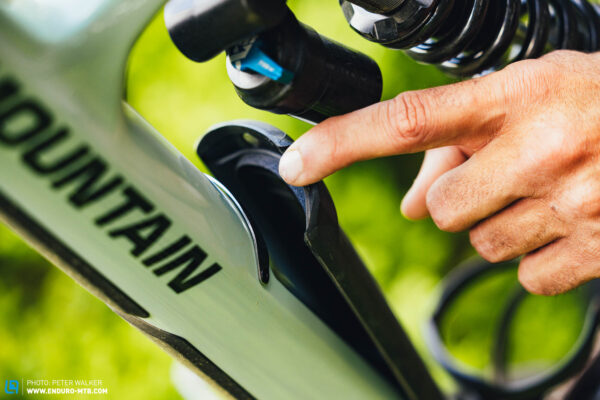
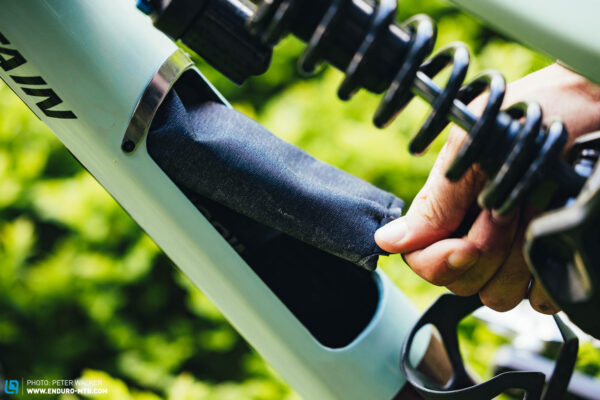
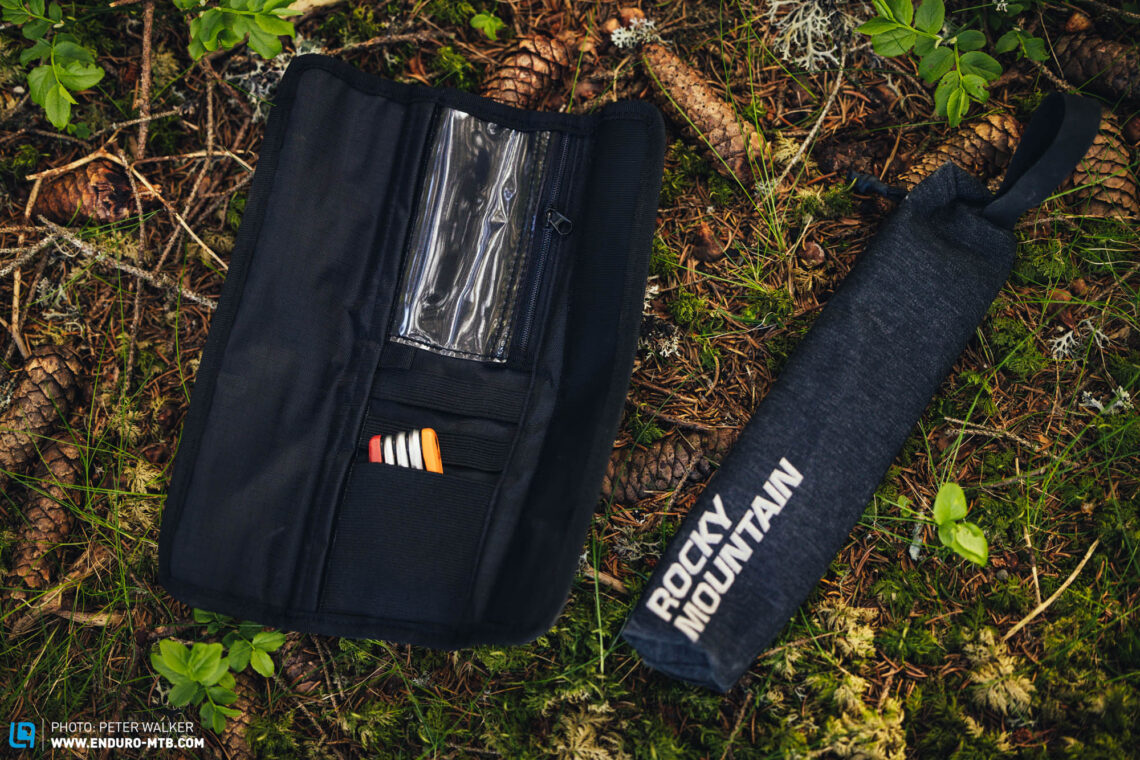
As already mentioned, the bottle cage doesn’t sit on the storage compartment’s cover, but at the bottom of the down tube. As a result, space is tight – so tight in fact, that we had to try three different bottle cages before we were finally able to squeeze a water bottle into the Slayer’s frame. However, to grab the bottle you’ll have to either be a contortionist or share the same arm span as Michael Jordan, because the bottle sits very low in the frame, making it hard to reach for mere mortals with average anatomies. While this isn’t particularly practical, the low position of the bottle should contribute to better weight distribution, which makes perfect sense with a freeride bike that wasn’t designed for long climbing sessions. To make sure that the new storage compartment/bottle cage combo fits snugly into the frame, Rocky Mountain’s engineers had to build a kink in the seat tube to fit around the bottle. If you don’t like this setup and prefer to have your water bottle within easy reach higher up in the frame, you should take a closer look at the Slayer’s alloy version.
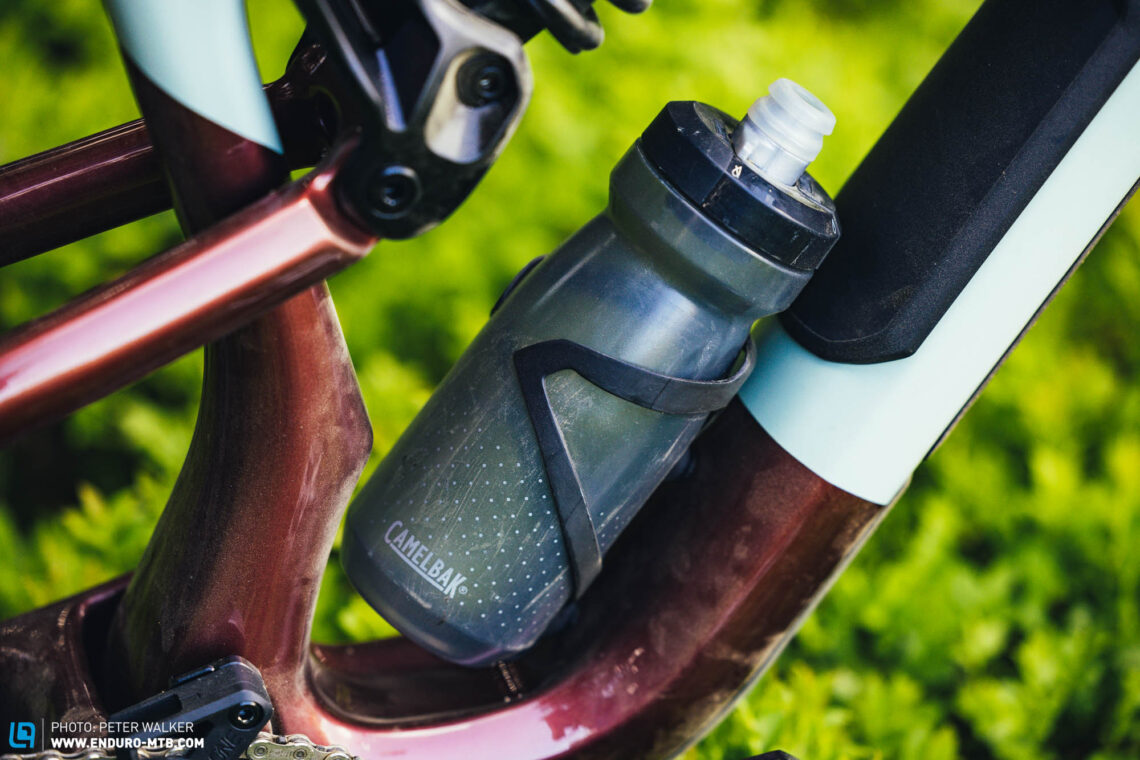
A longer service life – Rocky Mountain’s extensive frame protection for the new 2023 Slayer Carbon 50
Rocky Mountain want you to enjoy a high quality experience with the new 2023 Slayer, providing their latest freeride bruiser with countless frame protectors and internal cable routing. A massive, three-part TPU plate covers most of the downtube, protecting it against stray rocks and preventing scratches and paint chips when throwing your bike on the back of a truck. A generously sized chainstay protector extends far over the rear of the swingarm and is complemented by a big protector at the bottom of the seat stay. A OneUp bash guard protects the chain ring against nasty impacts and is paired with a matching OneUp TopGuide. The latter prevents the chain from falling off, and is secured to Rocky Mountain’s proprietary Candarm mount, which is attached directly to the main swingarm link – kind of cool!
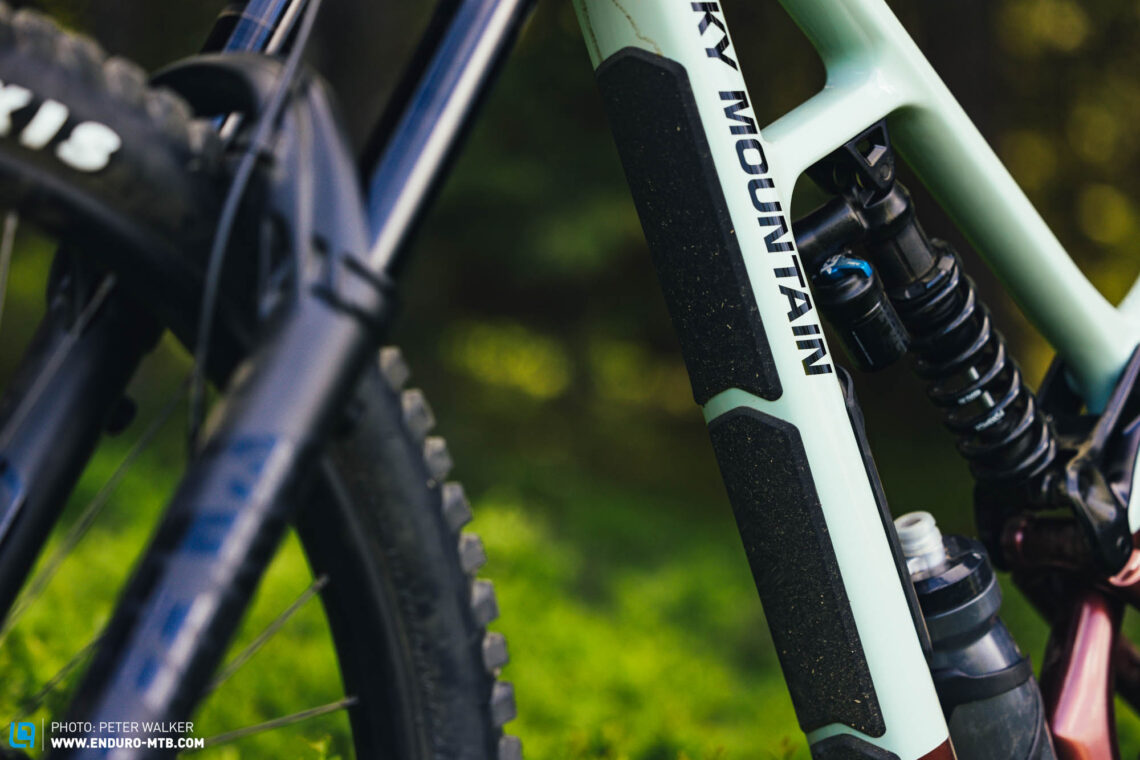


For the cable management, Rocky Mountain rely on a classic internal routing concept with conventional cable ports on the head tube. Compared to the previous Slayer frame, the cable ports have moved forward slightly and are now provided with two big cable clamps that can be securely bolted to the frame. Inside the frame, the cables and wires run through additional guide sleeves, making it easier to find them at the exit point. However, the cables reappear briefly in the area of the storage compartment, where they rattle loudly against the frame on rough trails. On top of that, the brake hose runs close to the seat stay just before it reaches the rear brake calliper, which adds to the Slayer’s rattling concert – what a pity!
The price killer? – The spec of our 2023 Rocky Mountain Slayer Carbon 50 in detail
The Carbon 50 is the gateway to the Slayer’s carbon dimension. Retailing at € 6,900, it’s the entry-level model in the carbon line-up and comes equipped with a beefy 180 mm FOX 38 Performance fork. Unfortunately, this employs the basic GRIP damper, which only offers limited adjustment options and doesn’t respond as sensitively as its top-tier counterpart, FOX’s high-quality GRIP2 damper. At the rear, a matching FOX DHX2 Performance Elite coil shock controls 180 mm of travel and, like the fork, only offers few adjustment options, delivering a rather poor performance on the trail – but more on this later. The Slayer comes with size-specific shock tunes and spring rates – for example, with a 450 lbs spring on our size L test bike. If you don’t meet Rocky Mountain’s anatomic standards and exceed (or fall short of) the recommended weight for the standard spring, swapping to another spring can be a real pain. To change it, you need a proprietary tool, which isn’t something everyone has in their workshop.

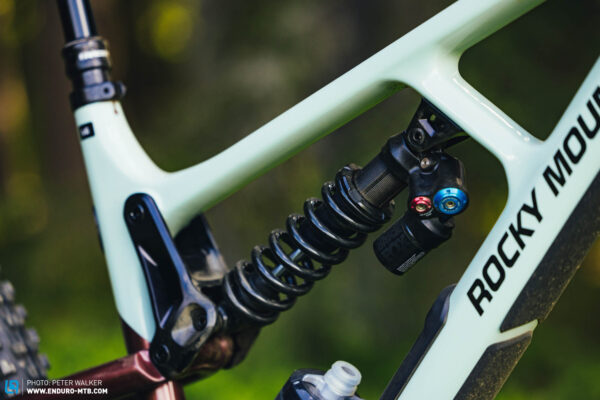
Shimano supply the SLX drivetrain and matching brakes, which might be from their cheaper series, but deliver a solid performance on the trail. Furthermore, the four-piston stoppers are paired with big 200 mm rotors front and rear. That said, heavy riders and those who use their bike primarily for epic bike park sessions, should consider upgrading to bigger 220 mm brake rotors (at least at the front). One thing we can’t complain about is the choice of tires: the Canadians combine an aggressively profiled MAXXIS ASSEGAI with soft MaxxGrip rubber compound at the front and Minion DHR II in the somewhat harder but more durable MaxxTerra rubber compound at the rear, both in the tough DoubleDown casing. Moreover, Rocky Mountain deliver all their Slayer carbon models with CushCore XC tire inserts, which are designed to protect the rims and tires from punctures, allowing you to run lower air pressures for more traction. While Rocky Mountain deserve a massive round of applause for their foresight, we can’t get our head around why they use a lightweight CushCore XC tire insert instead of the sturdier Trail or PRO versions. The XC model might weigh less, but was designed specifically for Cross Country racing and moderate trail riding, thus struggling to provide the right level of puncture protection and sidewall support in hard compressions. That said, a XC insert is still better than no insert at all ;)
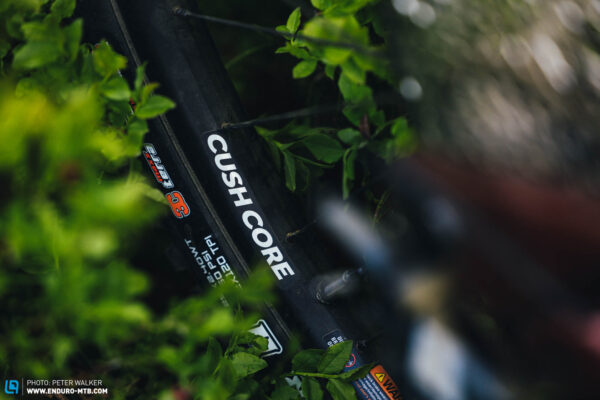
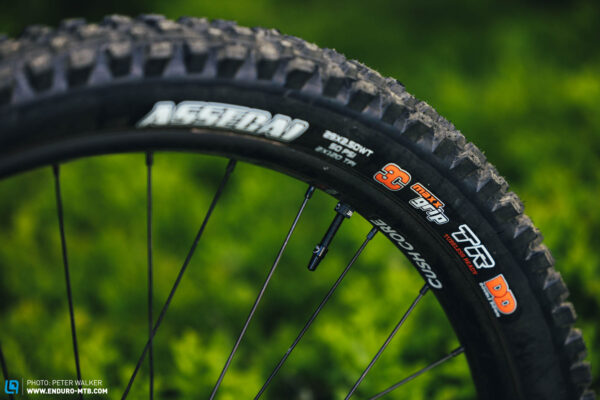
Tires and inserts are fitted to a WTB alloy wheelset, which threw in the towel just a few bike park laps into the test. On several test bikes, the rear wheel spokes all became loose, resulting in a fleet of buckled wheels. For the rest of the spec, Rocky Mountain source their components locally, relying on fellow Canadians Race Face and OneUp. The Race Face Aeffect R Dropper works flawlessly and is combined with a Shimano remote, which ensures excellent ergonomics. That said, in frame sizes L and XL, the dropper only offers 175 mm of travel, which is far below modern standards, thus restricting freedom of movement on the bike unnecessarily.

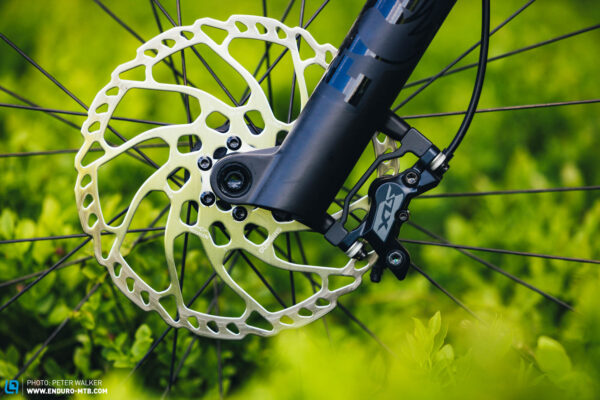

Rocky Mountain Slayer C50
€ 6,900
Specifications
Fork FOX 38 Performance 180 mm
Rear Shock FOX DHX2 Performance Elite 180 mm
Seatpost RaceFace Aeffect R 125 – 175 mm
Brakes Shimano SLX 200/200 mm
Drivetrain Shimano SLX 1x12
Stem Rocky Mountain 35 AM 40 mm
Handlebar Rocky Mountain AM 780 mm
Wheelset WTB ST i30 TCS 2.0 29"/27.5" in S-M / 29" in L-XL
Tires MAXXIS ASSEGAI MaxxGrip DD/ MAXXIS Minion DHR II MaxxTerra DD 2.5"/2.4"
Technical Data
Size S M L XL
Weight 16.8 kg
Specific Features
CushCoreXC Tire-Inserts
PenaltyBox
Flip Chip
More spec variants of the 2023 Rocky Mountain Slayer
The Rocky Mountain Slayer is available in three carbon variants and three aluminium versions. The Carbon 90 flagship model comes equipped with the finest FOX and Shimano components, as well as a fancy Race Face ARC Carbon 31 wheelset. However, for all the bling you’ll have to fork out a whopping € 11,500 or the current equivalent in maple syrup. The Slayer Carbon frameset retails at € 4,700.
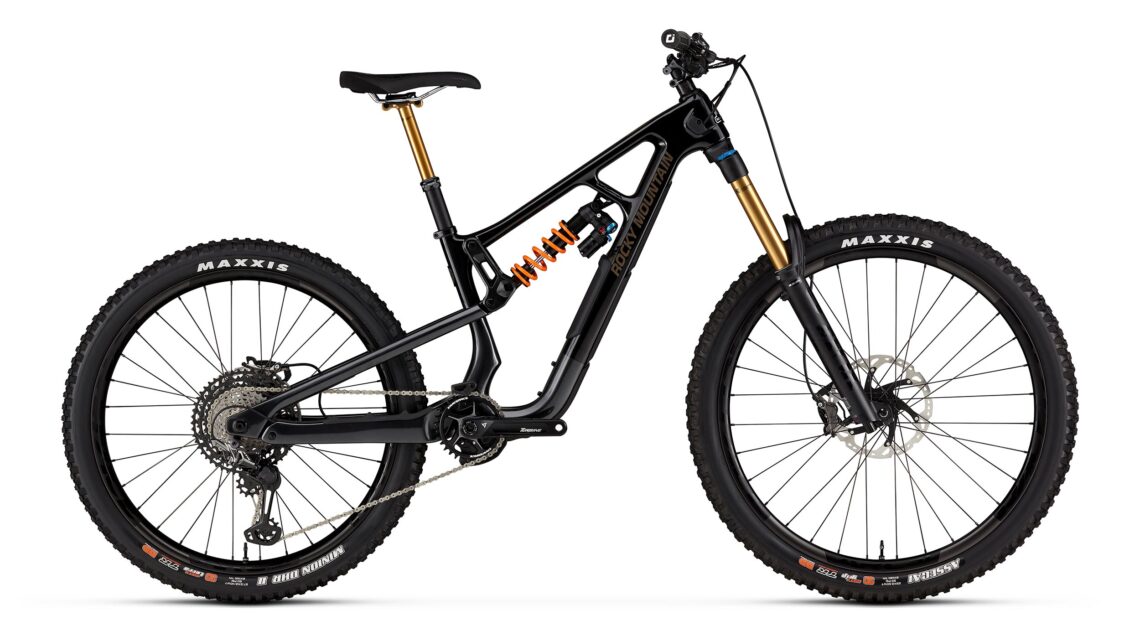
Rocky Mountain Slayer C90
€ 11,500
Specifications
Fork FOX 38 Factory 180 mm
Rear Shock FOX DHX2 Factory 180 mm
Seatpost FOX Transfer Factory 125 – 200 mm
Brakes Shimano XTR 200/200 mm
Drivetrain Shimano XTR 1x12
Stem RaceFace Turbine R 40 mm
Handlebar RaceFace Next R 780 mm
Wheelset RaceFace ARC Carbon 31 29"/27.5" in S-M / 29" in L-XL
Tires MAXXIS ASSEGAI MaxxGrip DD/ MAXXIS Minion DHR II MaxxTerra DD 2.5"/2.4"
Technical Data
Size S M L XL
Specific Features
CushCoreXC Tire-Inserts
PenaltyBox
Flip Chip
The 2023 Rocky Mountain Slayer Carbon 70 sits right in between the Carbon 90 flagship model and our Carbon 50 test bike. It features a FOX 38 Performance Elite fork, which might lack the fancy Kashima coating of the top-tier Factory model, but delivers the same tremendous performance on the trail. Shimano supply the XT drivetrain and matching XT brakes, which are very popular thanks to their excellent price-performance ratio. The Slayer Carbon 70 is extremely well specced and retails at € 8,700.

Rocky Mountain Slayer C70
€ 8,700
Specifications
Fork FOX 38 Performance Elite 180 mm
Rear Shock FOX DHX2 Performance Elite 180 mm
Seatpost RaceFace Turbine R 125 – 200 mm
Brakes Shimano XT 200/200 mm
Drivetrain Shimano XT 1x12
Stem Rocky Mountain 35 AM 40 mm
Handlebar Rocky Mountain AM 780 mm
Wheelset RaceFace ARC 30/ HD30 29"/27.5" in S-M / 29" in L-XL
Tires MAXXIS ASSEGAI MaxxGrip DD/ MAXXIS Minion DHR II MaxxTerra DD 2.5"/2.4"
Technical Data
Size S M L XL
Specific Features
CushCoreXC Tire-Inserts
PenaltyBox
Flip Chip
Alongside the three carbon models, Rocky Mountain also offers two, more affordable spec variants with an alloy frame. The Slayer Alloy 50 and Slayer Alloy 30 come equipped with suspension from RockShox and Marzocchi rather than FOX. Moreover, if you pick one of the alloy models, you’ll have to renounce the Penalty Box storage compartment as well as the CushCore tire inserts.
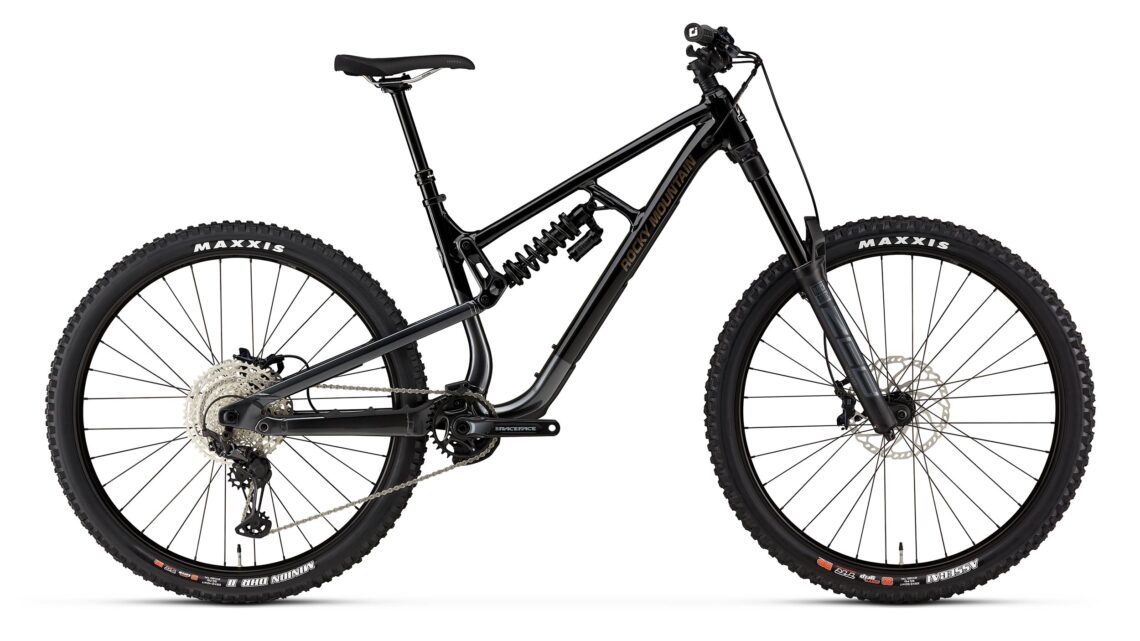
Rocky Mountain Slayer A50
€ 5,400
Specifications
Fork RockShox Zeb Select RC 180 mm
Rear Shock RockShox SuperDeluxe Coil Select+ 180 mm
Seatpost RaceFace Aeffect R 125 – 175 mm
Brakes Shimano SLX 200/200 mm
Drivetrain Shimano SLX/XT/Deore 1x12
Stem Rocky Mountain 35 AM 40 mm
Handlebar Rocky Mountain AM 780 mm
Wheelset WTB ST i30 TCS 2.0 29"/27.5" in S-M / 29" in L-XL
Tires MAXXIS ASSEGAI MaxxGrip DD/ MAXXIS Minion DHR II MaxxTerra DD 2.5"/2.4"
Technical Data
Size S M L XL
Specific Features
Flip Chip

Rocky Mountain Slayer A30
Specifications
Fork RockShox Domain RC 180 mm
Rear Shock Marzocchi Bomber CR 180 mm
Seatpost Rocky Mountain Toonie 125 – 170 mm
Brakes Shimano MT4120 200/200 mm
Drivetrain Shimano Deore 1x12
Stem Rocky Mountain 35 AM 40 mm
Handlebar Rocky Mountain AM 780 mm
Wheelset WTB ST i30 TCS 2.0 29"/27.5" in S-M / 29" in L-XL
Tires MAXXIS ASSEGAI MaxxGrip DD/ MAXXIS Minion DHR II MaxxTerra DD 2.5"/2.4"
Technical Data
Size S M L XL
Specific Features
Flip Chip
The new Slayer is also available as a special-edition model with a downhill oriented spec, which makes it the perfect bike park rental fleet mule: the Slayer Alloy 30 Park. This employs a 200 mm RockShox Boxxer Select RC dual crown fork, SRAM Guide RE brakes and a 7-speed GX DH drivetrain.
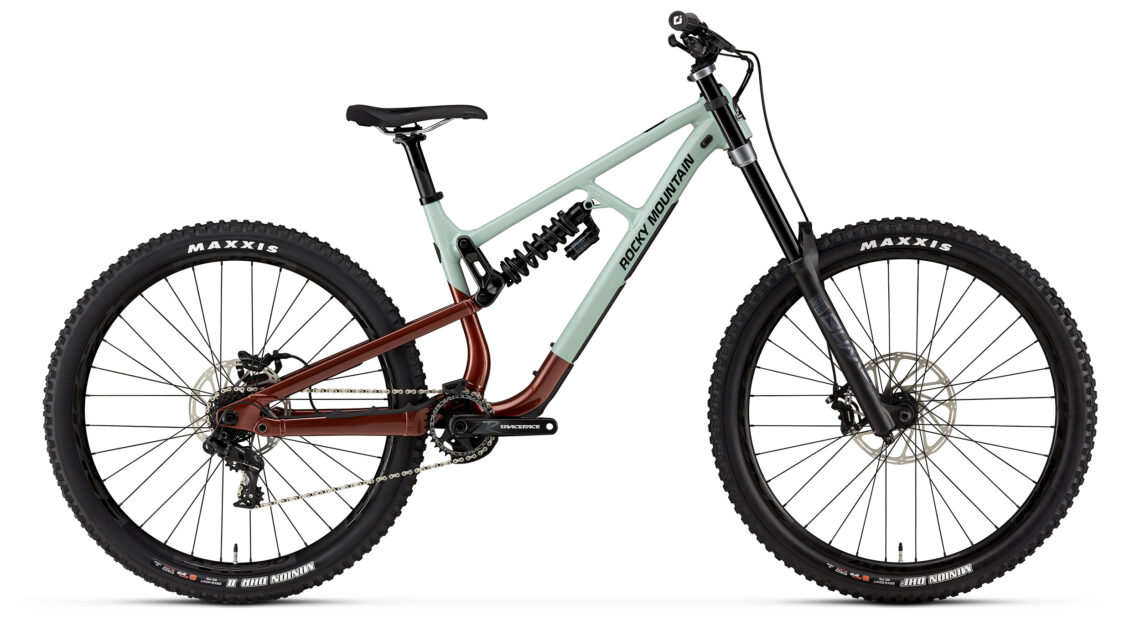
Rocky Mountain Slayer A30 Park
Specifications
Fork RockShox Boxxer Select RC 200 mm
Rear Shock RockShox Super Deluxe Coil Select 180 mm
Seatpost Rocky Mountain SL mm
Brakes SRAM Guide RE 220/200 mm
Drivetrain SRAM GX HD 1x7
Stem Rocky Mountain 35 CNC DH mm
Handlebar Rocky Mountain AM 780 mm
Wheelset RaceFace ARC HD30 29"/27.5" in S-M / 29" in L-XL
Tires MAXXIS Minion DHF MaxxGrip DH/ MAXXIS Minion DHR II MaxxGrip DH 2.5"/2.4"
Technical Data
Size S M L XL
Specific Features
Flip Chip
Stretch bench or butcher’s block? – The geometry of the 2023 Rocky Mountain Slayer Carbon 50 in detail
The 2023 Rocky Mountain Slayer relies on the same RIDE4 system as its predecessor. A flip chip in the shock mount allows you to fine-tune the bike’s geometry as well as the suspension progression. When looking from the drive side, when the shock bolt is in the bottom-right position, the bike’s geometry is in the neutral position (3). If you turn the flip chip anti-clockwise to position 4, with the shock bolt in the top right corner, you’ll steepen up the head and seat tube angle by 0.3° respectively, while at the same time lifting the bottom bracket by 3 mm. By turning the flip chip anti-clockwise further into position 2 and 1, you’ll set your bike in the slacker settings. Compared to the neutral flip chip position (3), the head and seat tube angles are 0.5 slacker and the bottom bracket 7 mm lower. In terms of suspension progression, position 1 has the highest progression while position 4 offers the lowest. We strongly recommend playing around with all of the different settings, as these clearly affect the bike’s handling. Only by trying different configurations will you be able to find the setting that suits your riding style and trails best. We felt most comfortable with the neutral position (3) and therefore recommend it as a starting point.
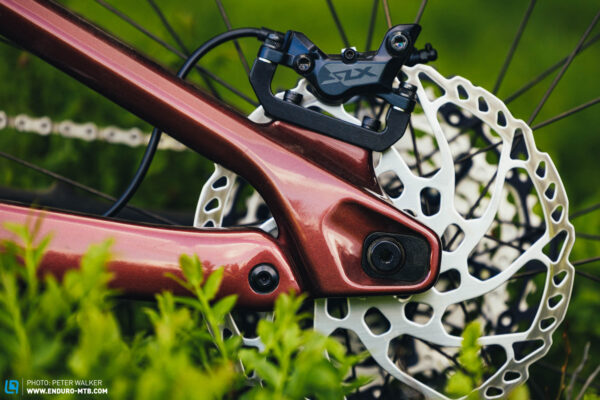
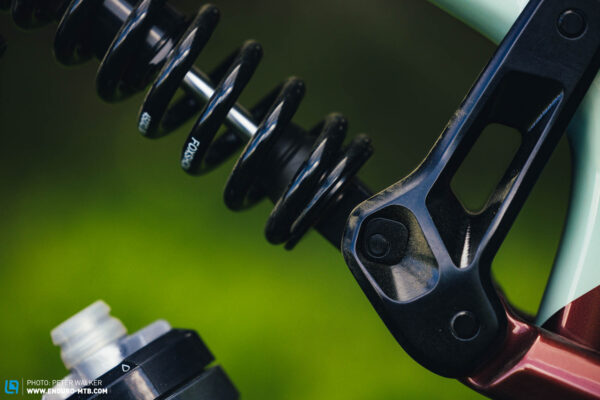
What’s also new on the Slayer, but has already been in use on other Rocky Mountain models, is the flip chip in the chainstays, which allows you to extend the wheelbase by 10 mm, regardless of the wheel size. That said, the chainstay length doesn’t grow with the frame size. What’s particularly cool is that the system doesn’t require any additional hardware, because the adapter of the brake calliper can be turned to match the respective setting, making sure the calliper always sits in the right position on the rotor. Furthermore, the latest iteration of the Slayer has a slightly shorter seat tube across all frame sizes. The head tube angle, which was already on the slack side with the 2020 model, is even slacker, while the seat tube angle has steepened up slightly. And while the new Slayer is also significantly longer across the board, reach values have only increased marginally – and weren’t extreme to begin with! The Rocky Mountain Slayer is available in four sizes, S to XL, whereby the two smaller sizes roll out of the factory as mullet bikes (29″/27.5″) and frame sizes L and XL are full 29ers.
| Sizes Pos.3 neutral | S (29″/27.5″) | M (29″/27.5″) | L 29″ | XL 29″ |
|---|---|---|---|---|
| Seat tube | 380 mm | 410 mm | 440 mm | 470 mm |
| Top tube | 567 mm | 592 mm | 621 mm | 653 mm |
| Head tube | 100 mm | 100 mm | 110 mm | 125 mm |
| Head angle | 63° | 63° | 63° | 63° |
| Seat angle | 77.5° | 77.5° | 77.5° | 77.5° |
| Chainstays | 439 – 449 mm | 439 – 449 mm | 439 – 449 mm | 439 – 449 mm |
| BB Drop | 22 mm | 22 mm | 22 mm | 22 mm |
| Wheelbase | 1,224 mm | 1,249 mm | 1,280 mm | 1,317 mm |
| Reach | 430 mm | 455 mm | 480 mm | 510 mm |
| Stack | 619 mm | 619 mm | 634 mm | 647 mm |
The 2023 Rocky Mountain Slayer Carbon 50 on the trail
For this first ride review, we were able to test the new Rocky Mountain Slayer Carbon 50 at both the Schladming bike park and Greenhill bike park. However, as already mentioned, we had to deal with some shock issues, because we had no access to a matching spring, and the special tool wasn’t available at the press camp either. As a result, we had to swap the standard shock for a RockShox Super Deluxe Select+, which had the right tune and allowed us to ride with the standard 30% sag.

If you decide to make your way to the top of the mountain under your own steam, it’s a good idea to activate the climb switch, because without it, the rear suspension bobs noticeably, swallowing up your input like a sandbag. Even in the steep setting (4), the riding position is rather slack, positioning you far behind the bottom bracket – but that’s not what the Slayer’s designed for anyway ;)

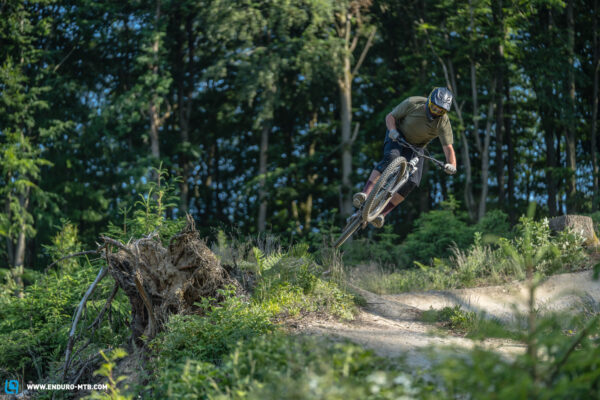
When gravity takes over, you’re nicely integrated with the frame, regardless of the flip chip setting. While at first this inspires lots of confidence, as soon as you hit a berm, you’re in for a rough reality check, because the plush, undefined rear suspension sinks deep into its travel with bigger bumps and active riding input, forcing you to shift your weight over the front wheel to keep it tracking. As a result, the Slayer forces you to constantly move your body around the bike, switching between push-ups and squats to manoeuvre the bike. This is also due to the suspension on our test bike, because the GRIP damper of the FOX 38 fork provides poor small bump compliance and little support, hardening up quickly with fast consecutive impacts. In a normal riding position, it sits high in its travel, but bottoms out quickly with hard landings. On the other hand, the shock provides hardly any support and swallows up the rider’s input like a sandbag, failing to provide feedback from the ground. Overall, the Slayer feels unbalanced and unpredictable, requiring a vigilant riding style.


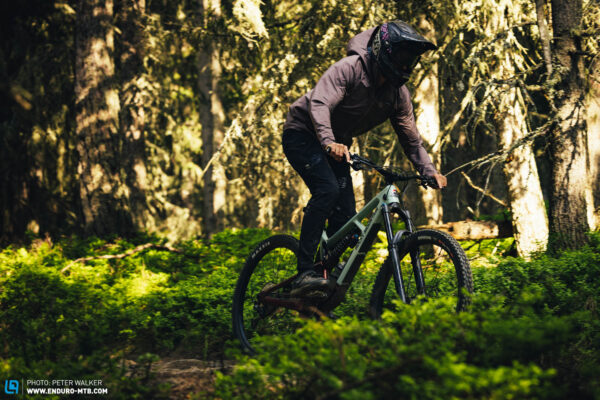
With the Ride 4 system in the slack setting (1), the rear suspension feels even softer, resulting in vague, sluggish handling through corners and in narrow trail sections, together with the slack 62.5° head angle. The high setting (4), on the other hand, ensures more agile handling but also increases reach by 10 mm, which requires you to actively shift your weight over the front to keep it tracking. As a result, we felt most comfortable with the flip chip in the neutral setting (3), which strikes the best balance between rear-suspension performance and handling. The soft, undefined rear suspension quickly blows through its travel, even with smaller drops and jumps, making you feel as if you were riding a less potent bike with far less travel – what a pity!
We’re already back on the trails testing the Slayer with other components, and will soon be able to tell you how these changes affect its handling. Stay tuned!
Conclusions about the 2023 Rocky Mountain Slayer Carbon 50
In this first test, the new 2023 Rocky Mountain Slayer Carbon 50 failed to live up to our high expectations, which is rather unusual for a fine bike brand like Rocky Mountain. As a result, we didn’t feel like venturing on any wild freeride sessions or epic bike park laps. The new features might look great at first but make for a loud, annoying rattling concert and unnecessary treasure hunts for parts. On the trail, our test bike was clearly slowed down by its own spec, with the poor suspension performance and flimsy rear wheel robbing us of our last ounce of joy.
Tops
- Countless geometry settings
- Tire inserts as standard
- Extensive frame protection
Flops
- Poor suspension performance
- Loud rattling noise on the trail
- Flaws in the spec
For more information, visit Rocky Mountain’s website.
